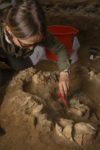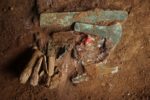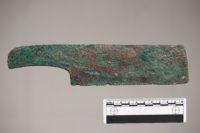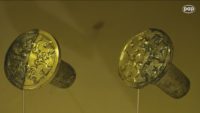 Archaeologists almost literally fell into the tomb of a 1,200-year-old metallurgist during an excavation in Huarmey, Peru. The team from the Warsaw University’s Centre for Precolumbian Studies was exploring a ceremonial square where religious rituals where known to have taken place and the remains of sacrificed llamas have been discovered. One of the students working on the site didn’t notice there was a deep hole near him until his leg fell into it. He was fished out unharmed and archaeologists decided to check out that hole deliberately this time.
Archaeologists almost literally fell into the tomb of a 1,200-year-old metallurgist during an excavation in Huarmey, Peru. The team from the Warsaw University’s Centre for Precolumbian Studies was exploring a ceremonial square where religious rituals where known to have taken place and the remains of sacrificed llamas have been discovered. One of the students working on the site didn’t notice there was a deep hole near him until his leg fell into it. He was fished out unharmed and archaeologists decided to check out that hole deliberately this time.
The space contained the burial of a young man. Because of the location of the grave initially the archaeologists thought he was a sacrifice victim, but further investigation found no evidence that the man, about 20 years old at time of death, had been ritually killed. He was placed in the wet clay of the grave in a seated posture wrapped in a textile which has not survived. We know it was there because its pattern left an imprint on the clay.
 When the first skeletal remains were unearthed, there were no grave goods found in the burial space. Complete excavation revealed that the youth was indeed buried with objects, a dozen used tools. It just took them a while to find them because they were all placed in one location: on his chest with his hands on top of them. They were tools, most of them bronze — a fine-toothed saw, an axe, several knives, a chisel — and had originally been bundled in fabric as well. Some fragments of that textile have survived.
When the first skeletal remains were unearthed, there were no grave goods found in the burial space. Complete excavation revealed that the youth was indeed buried with objects, a dozen used tools. It just took them a while to find them because they were all placed in one location: on his chest with his hands on top of them. They were tools, most of them bronze — a fine-toothed saw, an axe, several knives, a chisel — and had originally been bundled in fabric as well. Some fragments of that textile have survived.
Analysis carried out by Toronto University’s Branden Rizzuto showed that the tools were made of a rare type of bronze – copper alloy with arsenic, rather than more common tin.
[Dig leader Prof. Miłosz] Giersz said: “The alloy with arsenic guaranteed that these were really hard tools that could be used for a variety of farm and carving jobs.”
The most astonishing finding was an obsidian knife, as the material was rare in the Wari culture. Giersz explained: “Obsidian was considered a very valuable raw material in the Wari culture, as well as in other cultures of America, it was imported from a very long distance, this particular one from Quispisis, obsidian outcrops located over a thousand kilometers in a straight line north of Huarmey”.
 There is extensive wear and tear on the tools which strongly suggest they were the tools of the deceased’s trade. Some of the teeth are broken off on the saw, others are bent. The saw is also decorated. There’s a rectangular grid design in the middle, a pattern seen on ceramic vessels from that period which is believed to have been a maker’s mark. Perhaps this was his maker’s mark as well.
There is extensive wear and tear on the tools which strongly suggest they were the tools of the deceased’s trade. Some of the teeth are broken off on the saw, others are bent. The saw is also decorated. There’s a rectangular grid design in the middle, a pattern seen on ceramic vessels from that period which is believed to have been a maker’s mark. Perhaps this was his maker’s mark as well.
Even stronger evidence that the young man was a professional metallurgist is the inclusion of slag in the burial. A byproduct of the smelting of ore, slag isn’t found at random in Wari tombs. Archaeologists believe it was a deliberate burial meant to symbolize his trade.
 The ceremonial square where he was found is located at the foot of a mountain. At the top of that same mountain, the Polish archaeological team discovered an enormously significant tomb in 2012. The tomb was intact, unlooted and held the remains of 64 individuals, most of them women, high-ranking aristocrats of the Wari empire, including three royal women in their own individual chambers. It was the first unlooted Wari royal tomb ever discovered, and it was filled with grave goods, around 1,200 artifacts made from precious metals, alabaster and other luxury materials. It dates to the 8th century, so around the same period when a young metallurgist was buried at the foot of the mountain.
The ceremonial square where he was found is located at the foot of a mountain. At the top of that same mountain, the Polish archaeological team discovered an enormously significant tomb in 2012. The tomb was intact, unlooted and held the remains of 64 individuals, most of them women, high-ranking aristocrats of the Wari empire, including three royal women in their own individual chambers. It was the first unlooted Wari royal tomb ever discovered, and it was filled with grave goods, around 1,200 artifacts made from precious metals, alabaster and other luxury materials. It dates to the 8th century, so around the same period when a young metallurgist was buried at the foot of the mountain.
20 is quite young, I wonder whether he was in the habit of sucking on his tools and so accumulated arsenic in his system?